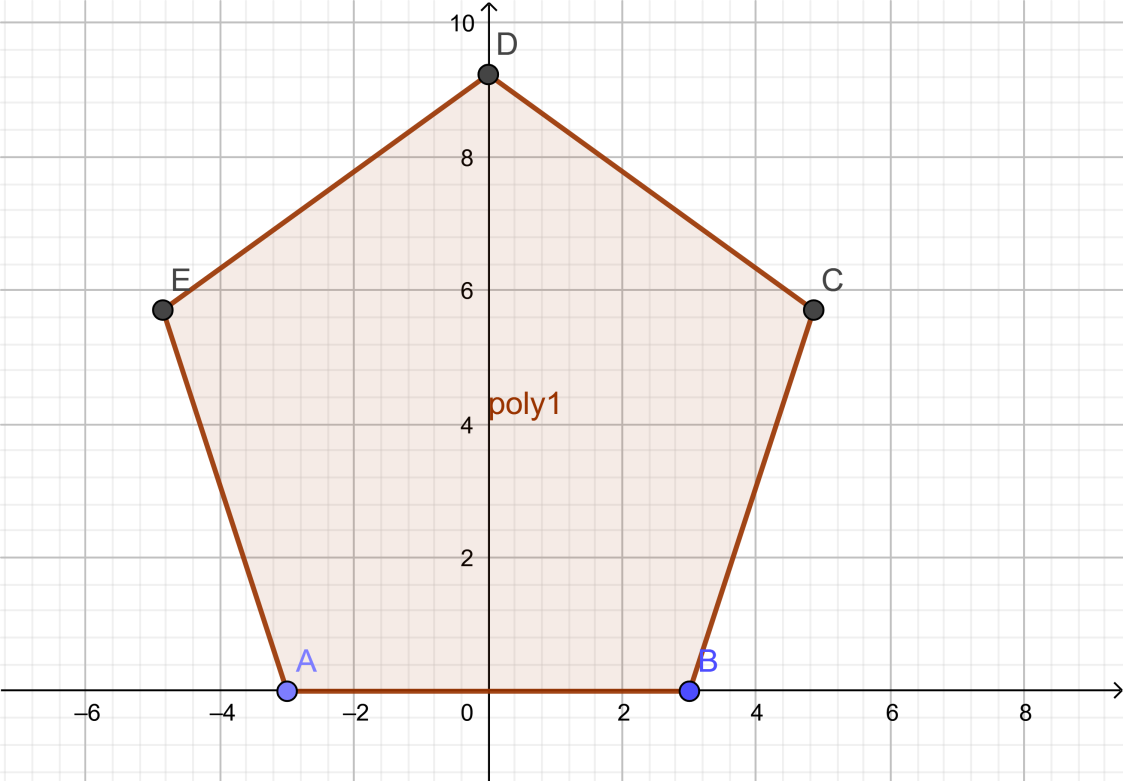
How many acute angles are there in a regular polygon?
(A). 2
(B). 0
(C). 3
(D). 4
Answer
593.1k+ views
Use the formula Sum of angles of a regular polygon = (n – 2) \[180{}^\circ \] to find the sum of all the internal angles of a pentagon and then equate it with the sum of angles. Use the condition i.e. “all the angles of a regular pentagon are the same” and solve the equation to get the final answer.
Complete step-by-step solution -
To solve the given question we will first draw a regular pentagon so that we can solve it easily, therefore,

As we have a regular pentagon with five sides and five angles.
Before we find the measure of angles; we should first find out the sum of angles of a pentagon.
Number of sides of a pentagon = 5 ……………………………………………………… (1)
To proceed further in the solution we should know the formula given below,
Formula:
Sum of angles of a regular polygon = (n – 2) \[180{}^\circ \]
If we substitute the value of equation (1) in the above formula we will get,
Sum of angles of a regular pentagon = (5 – 2) \[180{}^\circ \]
Therefore, Sum of angles of a regular pentagon = \[3\times 180{}^\circ \]
Therefore, Sum of angles of a regular pentagon = \[540{}^\circ \]
If we refer the above figure and write the angles, we will get,
$\therefore \angle A+\angle B+\angle C+\angle D+\angle E=540{}^\circ $ ………………………………………………………. (2)
Now, as we all know that all the angles of a regular pentagon are equal therefore from figure we can write, $\angle A=\angle B=\angle C=\angle D=\angle E$
Therefore the above equation will become,
$\therefore \angle A+\angle A+\angle A+\angle A+\angle A=540{}^\circ $
$\therefore 5\angle A=540{}^\circ $
$\therefore \angle A=\dfrac{540{}^\circ }{5}$
$\therefore \angle A=108{}^\circ $
Therefore, we can write,
$\therefore \angle A=\angle B=\angle C=\angle D=\angle E=108{}^\circ $
Now we know that acute angle is always less than $90{}^\circ $ and from the above equation it is clear that none of the angles of a pentagon is less than $90{}^\circ $.
Therefore, there are zero acute angles in a regular pentagon.
Therefore, the correct answer is option (b).
Note: Many students take the sum of pentagon as $360{}^\circ $ because they are in a hurry while writing the exam and therefore results in the wrong answer. Therefore do remember the formula Sum of angles of a regular polygon = (n – 2) \[180{}^\circ \] so that you can get the sum of angles of any pentagon.
Complete step-by-step solution -
To solve the given question we will first draw a regular pentagon so that we can solve it easily, therefore,

As we have a regular pentagon with five sides and five angles.
Before we find the measure of angles; we should first find out the sum of angles of a pentagon.
Number of sides of a pentagon = 5 ……………………………………………………… (1)
To proceed further in the solution we should know the formula given below,
Formula:
Sum of angles of a regular polygon = (n – 2) \[180{}^\circ \]
If we substitute the value of equation (1) in the above formula we will get,
Sum of angles of a regular pentagon = (5 – 2) \[180{}^\circ \]
Therefore, Sum of angles of a regular pentagon = \[3\times 180{}^\circ \]
Therefore, Sum of angles of a regular pentagon = \[540{}^\circ \]
If we refer the above figure and write the angles, we will get,
$\therefore \angle A+\angle B+\angle C+\angle D+\angle E=540{}^\circ $ ………………………………………………………. (2)
Now, as we all know that all the angles of a regular pentagon are equal therefore from figure we can write, $\angle A=\angle B=\angle C=\angle D=\angle E$
Therefore the above equation will become,
$\therefore \angle A+\angle A+\angle A+\angle A+\angle A=540{}^\circ $
$\therefore 5\angle A=540{}^\circ $
$\therefore \angle A=\dfrac{540{}^\circ }{5}$
$\therefore \angle A=108{}^\circ $
Therefore, we can write,
$\therefore \angle A=\angle B=\angle C=\angle D=\angle E=108{}^\circ $
Now we know that acute angle is always less than $90{}^\circ $ and from the above equation it is clear that none of the angles of a pentagon is less than $90{}^\circ $.
Therefore, there are zero acute angles in a regular pentagon.
Therefore, the correct answer is option (b).
Note: Many students take the sum of pentagon as $360{}^\circ $ because they are in a hurry while writing the exam and therefore results in the wrong answer. Therefore do remember the formula Sum of angles of a regular polygon = (n – 2) \[180{}^\circ \] so that you can get the sum of angles of any pentagon.
Recently Updated Pages
Master Class 9 Social Science: Engaging Questions & Answers for Success

Master Class 9 Science: Engaging Questions & Answers for Success

Master Class 9 English: Engaging Questions & Answers for Success

Master Class 9 Maths: Engaging Questions & Answers for Success

Master Class 9 General Knowledge: Engaging Questions & Answers for Success

Class 9 Question and Answer - Your Ultimate Solutions Guide

Trending doubts
Which places in India experience sunrise first and class 9 social science CBSE

Fill the blanks with the suitable prepositions 1 The class 9 english CBSE

Write the 6 fundamental rights of India and explain in detail

Difference Between Plant Cell and Animal Cell

What is pollution? How many types of pollution? Define it

What is the Full Form of ISI and RAW




